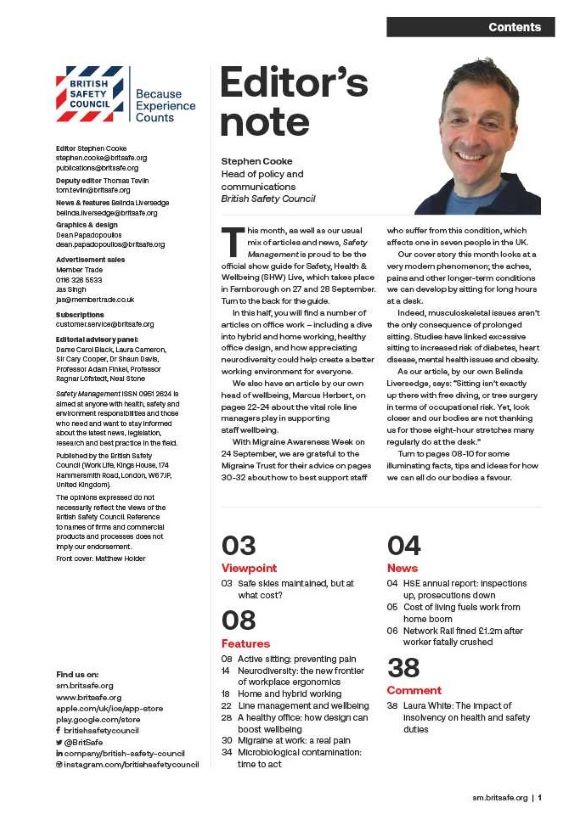Healthy ecosystems and biodiversity are crucial for everything from food production to absorbing carbon emissions – and businesses have a crucial role in reversing biodiversity loss.
Features
Boosting biodiversity: why businesses must act
Take a quick look around your house, office or wherever you are reading this article. The importance of biodiversity is all around us, from the tea or coffee we drink, the wood that makes up the furniture, the cotton in our clothes, the plastics in our computers and the petrol we put in our cars – both made from processed oil.
All these products are derived from plants at some point in their life cycle. Then there are myriad food and other products derived from animals – from glues to leather. Biodiversity is, simply put, the variety of life on earth. It encompasses the full spectrum of living things, from the tiniest of species all the way up to vast ecosystems that span continents.
Biodiversity loss is ranked third (behind climate change inaction and extreme weather impacts) in the list of long-term risks identified by leading risk experts as part of the Global Risk Perception Survey organised by the World Economic Forum. This year’s World Environment Day 2023 also centres on plastic pollution that has a devastating impact on both land and marine fauna and flora.
 Biodiversity loss is ranked third (behind climate change inaction and extreme weather impacts) in the list of long-term risks identified as part of the Global Risk Perception Survey. Photograph: iStock
Biodiversity loss is ranked third (behind climate change inaction and extreme weather impacts) in the list of long-term risks identified as part of the Global Risk Perception Survey. Photograph: iStock
The campaign (#BeatPlasticPollution) calls for global solutions to combat plastic pollution that destroys ecosystems. The world produces more than 430 million tonnes of plastic annually, two-thirds of which are short-lived products that soon become waste, entering rivers and oceans, and also harming ecosystems as they often work their way into the human food chain via microplastics.
There are two main facts about biodiversity that we should recognise. The first is widely known, but the second perhaps less so, and something I experience when conducting environmental and sustainability audits of businesses as part of my environmental consultancy role at the British Safety Council.
The first undeniable fact is that biodiversity is being destroyed at an exceptionally alarming fast rate. The Living Planet Report 2022 by the World Wildlife Fund (WWF), which is the most comprehensive study to date assessing trends in global biodiversity and the health of our planet, shows that global wildlife populations have plummeted by 69 per cent on average since just 1970. The decline across Latin America and the Caribbean is far greater than in any other region, with a 94 per cent decrease between 1970 and 2018.
However, it is fact number two that drives fact number one. Fact number two is that biodiversity loss has massive implications for business but this is often not considered by organisations as part of their day-to-day operations. Many organisations, and individuals, simply seem divorced from nature and their role in the biodiversity crisis.
For many companies, their materiality matrices – which consider current or long-term strategic risks to the organisation – do not take account of the current and future impact of biodiversity loss, despite all businesses being wholly reliant on biodiversity.
For many businesses, their ISO 14001:2015 risk register – which is designed to assess and record both the environmental impact of the organisation’s operations and the environmental risks the business faces – does not cover the risks to the business from biodiversity loss or the risk the business poses to biodiversity; although sometimes these registers refer to ‘resource depletion’ as a ‘catch all’ generic term.
 Anything we can do enhance and protect biodiversity and to reduce its loss can only be a good thing – whether as a standalone initiative at a business site, at home, through volunteering or social value days with staff. Photograph: iStock
Anything we can do enhance and protect biodiversity and to reduce its loss can only be a good thing – whether as a standalone initiative at a business site, at home, through volunteering or social value days with staff. Photograph: iStock
However, many businesses do capture biodiversity loss as a critical strategic and operational risk and understand the risks that it poses to their organisation.
There are many reasons for biodiversity loss, including natural causes, but by far the primary pressures are human-induced, including land and sea-use changes, direct over-exploitation of natural resources, climate change, pollution and the spread of invasive alien species.
We are not only facing a climate emergency but also a biodiversity loss crisis and there is increasing awareness that we need to think beyond net zero and consider our broader environmental impact, including biodiversity loss. Our current use of planetary resources is totally and completely unsustainable and from a business perspective alone, endangers the future stability of business operations.
Consequently, biodiversity is now seen as a fundamental component of the long-term survival of all business. All businesses, no matter their size or sector, are wholly reliant on genes, species and ecosystem services as critical inputs into their production processes. They also depend on healthy ecosystems to treat and dissipate waste, maintain soil and water quality and help control air composition.
Most businesses are heavily dependent on natural resources, but as the second fact above highlights, many are unaware of how the availability and quality of these resources are reliant on healthy ecosystems.
The contribution of ecosystem services to the global economy (food production, carbon storage, water and air filtration) is estimated to be worth more than $150 trillion annually, more than twice the world’s GDP. However, without an effective framework for estimating value, it is difficult to incorporate its worth into business models.
These are the ecosystem services that biodiversity provides because all business relies on biodiversity (either directly or indirectly), and all businesses can help manage and improve biodiversity. Although the private sector is part of the problem in causing biodiversity loss, it is also part of the solution. Business and nature are inextricably linked, so investing in biodiversity preservation and restoration should be a priority
for business.
 Keith Whitehead: "There are a lot of initiatives businesses can undertake to make a positive contribution to biodiversity enhancement on site and to reduce biodiversity loss in their supply chain."
Keith Whitehead: "There are a lot of initiatives businesses can undertake to make a positive contribution to biodiversity enhancement on site and to reduce biodiversity loss in their supply chain."
Biodiversity loss and natural ecosystem collapse are important to business for two main reasons – the associated business risks (dependencies), and the impact businesses have upon biodiversity and ecosystems (impacts).
The Taskforce on Nature-related Financial Disclosures defines dependencies as ecosystem services that an organisation relies on for its business processes to function, such as a clean and regular water supply.
Organisations also have impacts on environmental assets and ecosystem services that may be positive or negative. Short-term impacts on nature can result in changes in the quality and resilience of environmental assets, which in turn create medium- and long-term risks for organisations, given their dependencies. In short, today’s nature impacts can create tomorrow’s nature-related risks and opportunities. A recent example saw Govia Thameslink Railway use a tiny train and a floral display as part of an installation at London Blackfriars railway station to highlight their work in improving biodiversity across their rail network.
From a dependencies viewpoint, there are widespread significant economic consequences to biodiversity loss for business, with the UN suggesting that half the world’s GDP, or $44 trillion of value generation, is solely dependent on nature. Every year we are losing ecosystem services worth more than 10 per cent of our global economic output, putting lives and businesses at risk.
An assessment by the Natural Capital Finance Alliance, a collaboration with the UN Environment Finance Initiative, found that 13 of the 18 sectors that make up the FTSE 100 have production processes with high or very high material dependence on nature, representing $1.6 trillion in market capitalisation.
Business and nature are inextricably linked, so investing in biodiversity preservation and restoration should be a priority. By identifying dependencies and managing the risks, businesses can prevent supply chain disruptions, avoid regulatory costs, improve their investment profile, increase their attractiveness to employees and improve their efficiency. By considering nature-related contingencies, businesses can not only make their business more sustainable but also improve their resilience to environmental disturbance, such as climate change.
Improving the biodiversity impact of projects can increase their value, particularly with construction projects, where ecosystem services provided by biodiverse landscaping can reduce air pollution, decrease flooding and improve the physical and mental wellbeing of residents. Finally, there are reputational gains to be made through ethical operation, and there is likely to be increasing scrutiny of the impact that business has on biodiversity and nature.
The importance of an organisation’s biodiversity profile is expected to rise as the European Union (EU) is introducing mandatory reporting on biodiversity-related risks and impacts from top companies as part of the new Corporate Sustainability Reporting Directive (CSRD).
The requirement for compliance with new regulations is also a risk that needs to be considered when projecting the shape of future business. The CSRD applies to all companies meeting at least two of the following three criteria: €40 million net revenue, €20 million balance sheet and more than 250 employees. Most companies above this size based in the EU and EU subsidiaries of foreign companies will fall within the scope of the CSRD.
Under the Environment Act 2021, nearly all planning permissions granted in England for 10 or more homes will have to provide a 10 per cent biodiversity net gain (BNG). The Local Government Association defines BNG as an approach to development or land management that aims to leave the natural environment in a better state than it was beforehand.
In planning policy, an important element of BNG is the fact it is measurable. This means that, before any development begins, applicants need to measure the existing and proposed biodiversity values of their sites. However, although the Environment Act 2021 is now law, the BNG requirement will be phased in between November 2023 and April 2024, given the expected administrative issues it will create during its initial implementation.
Ultimately though, this means that, before any development begins, applicants need to measure the existing and proposed biodiversity values of their sites. They also need to set a clear plan for the proposed biodiversity net gain, and get that plan approved by their local authority.
BNG will be measured using Defra’s biodiversity metric and habitats and will need to be secured for at least 30 years.
BNG will need to deliver measurable improvements for biodiversity by creating or enhancing habitats in association with development. BNG can be achieved on-site, off-site or through a combination of on-site and off-site measures.
Company biodiversity action plans
Many businesses have proactive plans for managing and enhancing biodiversity, both on their sites and in the supply chain as part of a dedicated company biodiversity action plan (CBAP). Many British Safety Council member companies have drawn up and started to implement biodiversity action plans for their sites as voluntary initiatives and are looking at biodiversity impacts in their supply chains and purchasing decisions.
There are a lot of initiatives businesses can undertake to make a positive contribution to biodiversity enhancement on site and to reduce biodiversity loss in their supply chain. However, whatever approach a business takes to engaging with biodiversity, it is important that the initiatives are appropriate for the company size, the sector of business and the resources available.
Central to a successful CBAP are achievable goals. This may mean a phased approach, starting with activities which are less demanding in terms of resources and specialist expertise, and gradually expanding the programme over several years.
There are five stages that an organisation can plan for:
Stage 1: assess biodiversity on the business site and/or in the organisation’s supply chain.
The first stage in developing a CBAP is to assess the risks and impacts associated with biodiversity. This initial step can simply involve a basic ecological survey of the business site to establish the habitats and species of plants, animals, insects and birds that are present. This can be done even for sites like warehouses.
Other impacts may be more indirect, including those related to the company’s supply chain and the impacts of its products and services. A business therefore needs to understand its potential biodiversity impacts in order to identify the key areas to address in the CBAP. A full scientific ecological study of a business site will generally not be necessary or appropriate, though some larger landowners may decide to conduct one.
Stage 2: prioritisation
Once the habitats and species of plants, animals, insects and birds present on the business site – and any biodiversity impacts in the organisation’s supply chain – have been identified, the risks to and impacts on biodiversity must be assessed and priorities set for any measures to enhance biodiversity that the business wishes to implement.
A manufacturing site I worked with recently identified that some old oak trees at the site boundary had some bat roosts, so they worked with their local wildlife trust to put up additional bat boxes. Another company identified that the products they were selling in their canteen were made of palm oil and worked with the suppliers to introduce alternative products in the vending machines.
Stage 3: actions and monitoring
Once the main potential biodiversity impacts on-site, or in the supply chain, have been identified, and appropriate actions taken to enhance biodiversity, a monitoring programme should be established to assess the effects on biodiversity. Again, for small organisations this doesn’t have to be a large project. On some larger sites, monitoring can be undertaken by staff who are interested in getting involved in biodiversity initiatives. Data collected from the organisation’s sites should also be fed into the company’s environmental management system.
Stage 4: set targets and performance indicators
Setting realistic targets for the implementation of the CBAP can be key to its success. It may be appropriate to adopt a phased approach, starting with the highest-ranking priorities and introducing more targets when resources, time and business and staff interest allow it. Performance indicators should be used to demonstrate that the CBAP is having a positive effect on the biodiversity it aims to conserve on site and/or in the supply chain.
Stage 5: monitor, review and report
The CBAP should be reviewed on a regular basis. The key questions to ask include whether targets are being achieved; could more biodiversity issues be addressed; and can more be done to involve staff. Communicating biodiversity initiatives to staff and external stakeholders is an essential component of the CBAP. This may take the form
of a simple email, an article in the staff newspaper and/or on the company’s website and intranet, a section in the company’s existing sustainability report or a separate biodiversity report.
Final points
In conclusion, anything we can do enhance and protect biodiversity and to reduce its loss can only be a good thing – whether as a standalone initiative at a business site, at home, through volunteering or social value days with staff or via a more formal CBAP as described above. The only thing is do something and as the Chinese proverb states: “The best time to plant a tree was 20 years ago. The second best time is today.”
Dr Keith Whitehead CEnv is Senior environmental consultant at the British Safety Council
FEATURES

Pursuing workplace wellbeing through authentic leadership
By Dr Audrey Fleming, British Safety Council on 26 April 2024
By being open, honest and vulnerable in their interactions at work – and genuinely seeking and valuing the input of employees – leaders can develop a workplace atmosphere where trust and respect flourish, in turn supporting the wellbeing, engagement and performance of their teams.

Out in the field: why lone worker monitoring is key
By Rebecca Pick, Pick Protection on 26 April 2024
People working away from a fixed base out in the field may need to quickly summon assistance in an emergency, but it’s important to choose the right communications and alarm technology for their needs.

Why line managers play a vital role in workplace wellbeing
By Marcus Herbert, British Safety Council on 03 September 2023
The behaviours of line managers can have a positive or negative impact on employee health, wellbeing and engagement, so it’s vital managers get staff feedback on whether their management style is supportive or negative, and have regular check-ins so workers can raise concerns about their wellbeing.



